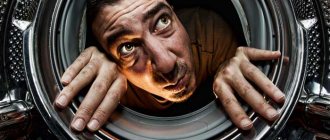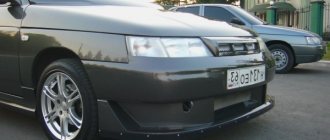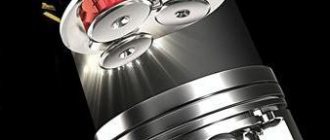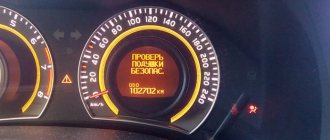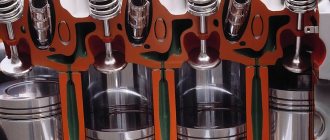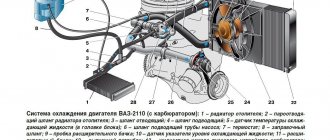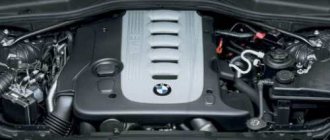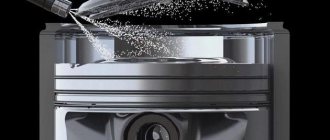In relation to a car, a jerk is a short-term spontaneous change in the speed of the engine crankshaft, regardless of the position of the accelerator pedal.
In everyday use, as a rule, there are a series of jerks. The extreme case of a jerk is a failure - a noticeable delay in the engine's response to pressing the accelerator pedal.
Conventionally, three types of jerks can be distinguished:
- at the moment of starting movement;
– with steady motion, i.e. with the accelerator pedal in constant position.
To determine the causes of jerks when driving a car with an injection engine, special diagnostic equipment is required, so in this case we recommend contacting a service that specializes in repairing fuel injection systems.
As practice shows, in most cases jerking is caused by insufficient fuel pressure in the fuel rail, malfunction of the throttle position sensor or mass air flow sensor.
If you have some skills, you can determine the cause of jerking yourself.
In what cases is a car “jerking” detected?
Most cases of car “jerking” are associated with problems with wear of spare parts or clogging of one of the car’s systems. While driving, you can detect vehicle twitching at the following stages:
- When starting only at the beginning of the car's movement;
- When driving at low speeds;
- During a sudden increase in speed;
- When driving at high speed;
- When driving in any mode (periodic shocks at different periods of time).
Consider the case of a vehicle malfunction when driving at low speeds.
Useful tips
Quite often, engine jerking at idle can occur precisely when the internal combustion engine is cold. In this case, you should pay special attention to the motor temperature sensor.
Failure or malfunctions in its operation often lead to the ECU receiving a premature signal to warm up the power unit, while the engine is still cold.
A similar situation can occur when air leaks appear or problems arise with the air flow sensor (MAF). In this case, the control unit incorrectly calculates the actual amount of air that enters the cylinders, as a result of which the correct ratio of fuel and air will be disrupted (disturbance of mixture formation).
What causes the car to jerk when running at low speeds?
Since the car begins to twitch when reaching even low speeds, it will not be possible to immediately identify one specific problem. Problems may be hidden:
- In the engine fuel mixture supply system;
- In the vehicle ignition system;
- At the checkpoint;
- In the distributor design;
- Includes fuel filters;
- In the sparking system;
- In the control unit of the vehicle's on-board computer.
Let's go through the faults in each of the listed systems in detail.
Tip: When detecting a “jerking” behavior in the vehicle, the brakes may also squeak when braking. These 2 problems can be either interrelated or indicate completely different breakdowns.
Checking the engine fuel mixture supply system
Often the reason that the car jerks at low speeds is due to a malfunction of the power system. When the car starts to move, the cylinders simply cannot receive the required amount of fuel mixture, as a result of which the car is unable to transfer the required amount of power to the chassis for smooth driving and smooth commissioning of the transmission. As a result of increased pressure and transmission resistance, uneven running of the machine appears.
To solve this problem, it is recommended that you first pay attention to checking the throttle body. It also wouldn’t hurt to test and diagnose the performance of the sensors installed in the system for determining idle speed indicators. Do not forget to check the serviceability of the throttle valve position and the mass air flow sensor.
Throttle body
During diagnostics, most often a breakdown is found in the injectors responsible for uniform injection of the fuel mixture. In rare cases, engine jerking problems may be related to the air ducts that connect the injector receiver to the air filter structure. Here the problem lies in depressurization of connections and loss of pressure.
The solution to the problem is to replace all faulty components yourself or with the help of car service specialists. After repair, it is recommended to ensure that all connections are in good working order and that there is no loss of pressure in the fuel line system that is connected to the fuel pump itself.
If a power unit with a carburetor system was installed in the engine compartment of your vehicle, then you need to check the idle valve and the absence of damage directly to the carburetor.
Checking the car's ignition system
Sometimes the car starts to jerk while driving at low speeds as a result of a breakdown in the ignition system. Basically, the problem will be caused due to untimely ignition of the fuel mixture and air flow. In rare cases, the malfunction may be hidden in the receipt of low voltage from the spark plugs. The spark voltage simply will not be enough to ignite the fuel mixture in a timely manner. Also, when diagnosing the ignition system, check:
- Performance of ignition coils;
- Serviceability of the spark plug set;
- No tears in high-voltage wires;
- There are no problems in the ignition distributor-interruptor (in simple terms - in the distributor);
- Correctness of values coming from a set of sensors responsible for the position of the camshaft and crankshaft;
- The performance of the switch located inside the entire structure.
Signs of engine tripping
Regardless of the reasons, engine tripping is associated with the presence of various problems, which can be solved after finding out what caused the stoppage of one of the cylinders of the internal combustion engine.
The main signs of engine tripping include
| № | Signs |
| 1 | uneven operation at idle, as well as shaking of the engine |
| 2 | darkening of one of the spark plugs |
| 3 | change in exhaust sound |
| 4 | poor acceleration dynamics of Priors at any speed |
| 5 | increased fuel consumption |
| 6 | floating speed, displayed on the tachometer by jerking the arrow |
| 7 | jerking when accelerating or driving |
Auto mechanics identify several reasons why jerking occurs and the engine begins to stall. The main ones are: incorrect ignition timing, faulty spark plugs and installed condenser, broken piston rings, piston and valve burnout, rocker wear, clogged air filter, and others.
The cause of the jerking must be sought in the cylinders
To reduce the search for the cause of engine tripping, it is recommended to determine which cylinders are not working correctly or have stopped functioning. To do this, you will need to remove the high-voltage wire from the spark plugs one by one. This procedure must be performed carefully, as there is a risk of electric shock. Before performing this work, you will need to place a dielectric base in the form of rubber or wood under your feet. It is recommended to remove by the wire. Then the engine speed increases to 1500 rpm. The valves are removed from the cylinders one by one. If the sound of the vehicle changes when removed, then the cylinder is working correctly. Otherwise, it must be replaced.
Idle speed sensor
If the car jerks while driving, first you need to check the idle speed sensor. A malfunction of the idle speed sensor is very difficult to identify, since most often it does not cause a Check Engine error, which signals the presence of problems and shows which unit is not working.
There are three main faults
- Sensor contamination. The sensor is contaminated with oils, dust, oils, crankcase gases
- Mechanical damage associated with the rod, threaded connection, rivets flying out, etc.
- Failure of the electrical part. These malfunctions include winding combustion or a short circuit inside the sensor.
Jerks when shifting gears Priora 16 valves
- To the beginning of the forum
- Forum Rules
- Old design
- FAQ
- Search
- Users
up to 30-40 or something? I've tried everything. The further you twist, the worse the second one sticks in and jerks stronger.
But if you turn in first and switch to second and don’t press on the gas, then it jerks...
up to 30-40 or something? I've tried everything. The further you twist, the worse the second one sticks in and jerks stronger.
Serg_x: decrypt. Didn't understand .
wait a minute. that is, up to 30-40 km/h, do you suggest I drive first?
So if you accelerate in the yard or in a traffic jam at first, then lift your foot off the pedal a little, you know what failures there are.
then explain to me why there is no twitching when I’m not spinning it up, but when I’m spinning it up - that’s exactly what they are, and they’re wild.
then explain to me why there is no twitching when I’m not spinning it up, but when I’m spinning it up - that’s exactly what they are, and they’re wild.
Source
Ignition system
One of the reasons why the car jerks while driving may be a faulty ignition system. The ignition system consists of:
- Candles
- Ignition coils or module
- High voltage wires
- Distributor
- ECU
Depending on the car, some elements may not be present, but the essence does not change.
In order to ignite the fuel in a specific cylinder, a spark is needed. To form it, the ECU supplies a small voltage to the ignition module. The ignition module increases this voltage, and from it it is transmitted through high-voltage wires to the spark plug. If everything happened without any problems, then a spark appears at the spark plug and the compressed fuel mixture ignites.
If there are problems (most often this is a breakdown of any element of the system), then a spark does not appear on the spark plug, the fuel does not ignite and the car begins to twitch when driving at low speeds and during acceleration.
Inspection of high voltage wire
Often, the Priora stalls when accelerating due to a malfunction of the ignition system. This is especially true for the condition of the high-voltage wire leading to the spark plug. To inspect it, you will need to remove the tip attached to the spark plug. The structure of a high-voltage wire is as follows: the winding contains the central core of the wire. The tip, which is put on the candle, has a persistent metal penny. The main purpose of this element is to transmit current to the spark plug.
The core of the high-voltage wire should fit as closely as possible to the “penny” of the steel tip placed on the spark plug. Due to aging, contact between this element and the wire may be lost due to oxidation of the metal. As a result, tripling occurs. The oxidation of the contact is checked as follows: with the second probe of the multimeter, you should touch the central core of the high-voltage wire; if the core of the high-voltage wire burns out along its entire length, then it is possible to identify such a section using a special multimeter tip.
The wire is pierced until the affected area is identified every 5-10 mm. If such a section is detected, it is cut off if the length of the high-voltage wire allows it. Otherwise, it needs to be replaced.
Transmission
Sometimes the car jerks at low speeds due to the clutch. This may be due to the fact that the springs on the disk, which are needed for a smoother transmission of torque, have failed.
On some cars, for example the 8th generation Honda Civic, jerking when pressing the clutch is a disease and can be treated by lubricating the fork, which moves the release bearing. As for cars with an automatic transmission, kicks and jerks when starting off indicate that the automatic transmission is on the brink, and will most likely need to be repaired soon.
Jerks when shifting gears Priora 16 valves
Vermilion
There are no reasons.
And there are bites. I was trying to understand why this is happening. 56 throttle for viburnum is almost enough. Good for general development.
I think it's in the air. maybe it’s in the DMRV? I measured the voltage with a tester - 1.037) is basically normal.
I checked the air leaks with a smoke generator. nothing was found. except that there was barely a hint of smoke between the dpdz. but this is so little that it doesn’t count.
Vermilion
There are no reasons.
And there are bites. I was trying to understand why this is happening. 56 throttle for viburnum is almost enough. Good for general development.
I think it's in the air. maybe it’s in the DMRV? I measured the voltage with a tester - 1.037) is basically normal.
I checked the air leaks with a smoke generator. nothing was found. except that there was barely a hint of smoke between the dpdz. but this is so little that it doesn’t count.
AMAROCK
Have you compared the IAC positions at the moment of releasing the gas and its subsequent (IAC) positions in cars with and without jerks? I also have these pecks/jerks (the super smart M73 doesn’t save their mother from this.). For example, when you throw on the gas in traffic jams somewhere from 1200 rpm in first gear, the IAC immediately takes the idle position (I now have 47.48), naturally there will be a dive, in my opinion it should smoothly subside within at least 1 second.
If you want, I'll test your theory on my car. the diagnostician himself. there is equipment.
but in principle, in the firmware there is a parameter for the speed to freeze when releasing the gas... that is, you released the gas at 2360 rpm, your brain delayed it for 0.5 milliseconds and dropped it to xx) that’s why the speed freezes when you release the gas. precisely because of this function. and then you have to look rrx or dpzd is buggy
but in principle, the firmware has a parameter for the speed to freeze when releasing the gas..
but in principle, the firmware has a parameter for the speed to freeze when releasing the gas..
Briefly speaking. Once again it's a mess. If possible, I’ll try to roll out the BCN and the correction this weekend. Let's see what happens.
What is your roar theory? Mechanical or electrical?
mechanical - I think it's the gearbox or clutch. in principle one relates to the other
electrical - mass air flow sensor. because the rxx was changed and checked for the resistance of the windings. because the DPDZ was also changed to contactless and nothing has changed. The lambda probe only works at 50 degrees for me. twitching appears even before 50)
or mz? checking his parallels showed nothing. There is no test stand.
Vermilion
The mechanics are very easy to check.
when you let off the gas.. immediately turn off the ignition (just don’t take out the key..) and see if the car jerks.. if not, then the clutch and suspension are ok. This means there is a problem in engine control. IMHO
Vermilion
The mechanics are very easy to check.
when you let off the gas.. immediately turn off the ignition (just don’t take out the key..) and see if the car jerks.. if not, then the clutch and suspension are ok. This means there is a problem in engine control. IMHO
Electric gas pedal
A common reason when the car jerks is the failure of the electronic gas pedal. Modern cars have an electronic gas pedal. It works on the principle of a potentiometer and has a structure similar to it. Like any potentiometer, it has tracks along which the sensor runs. This sensor is mechanically connected to the pedal.
Although the gas pedal housing is hermetically sealed, it sometimes happens that moisture gets into it, and as you know, electronics do not like moisture. Since the tracks are made of metal, they begin to corrode. This reduces contact with the sensor. The pedal starts to work incorrectly and the car jerks when you press it. Dips are felt both at idle and while driving.
Reason 4 – fuel filter
This is perhaps one of the most common reasons why the Lada Priora twitches.
Like any other filter, the fuel filter becomes clogged over time. The reason is low-quality fuel and dusty air, so it is better to refuel at proven gas stations.
You can check a clogged filter yourself using a conventional pressure gauge, tube and clamp. For this:
- Unscrew the cap from the fuel rail fitting.
- Using the tire nipple cap, unscrew the spool and connect the pressure gauge, securing the tube with a clamp.
- Start the car and check the pressure reading. If it is less than normal - 3.8-4 kgf/cm2, the cause of the twitching most likely lies in the filter.
At a service center, a pressure check service will cost about 300 rubles.
You can replace the fuel filter at home. The part costs about 300 rubles. If there is no desire or opportunity, contact the service center. There they will charge from 500 rubles for the service.
Also read: Risks of purchasing and maintaining Volkswagen Polo V
Engine or gearbox mounts
The main car components, such as the engine or gearbox, are attached to the body using cushions. The main purpose of this device is to fasten and dampen vibrations during operation. Old cars often had cushions made of durable rubber, which rarely failed.
On modern cars, hydraulic mounts are installed. This device contains a special hydraulic fluid, and this type of pillows smoothes out vibrations better.
If the cushion bursts or has a tear, then at the beginning of the movement the car will jerk due to the fact that the main units do not have a strong connection with the body.
Replacing spark plugs yourself
Replacing spark plugs on a Lada
Since faulty spark plugs occur most often during acceleration failures, auto mechanics recommend Lada Priora owners learn how to change this element of the ignition system themselves. This should be done after the car has traveled 20 thousand km. However, if the engine starts to trip, the spark plugs should be replaced before this date:
- Initially, you will need to clean the engine compartment from dirt and debris,
- Next, it is necessary to dismantle the engine elements to gain unhindered access to the spark plugs. Adapters and extensions are used for this. Before performing this work, you will need to wait until the engine has completely cooled down.
- The spark plugs are unscrewed one by one, and the high-voltage wires are disconnected. To prevent an accident, you must first remove the battery from the car. Otherwise, electricity may be supplied. When performing this procedure, it is recommended to monitor the force applied. It is better to seek help from specialists if the candle does not budge.
- To prevent debris from getting into the resulting holes, you need to cover them,
- The candles are screwed in manually at the first stage. Next, they are tightened using a special mechanism that allows you to measure the amount of force applied,
- high voltage wires are connected,
- engine operation is checked,
- The previously dismantled elements are assembled in the reverse order.
To ensure stable engine operation, spark plugs should be replaced regularly.
Engine temperature sensor
Modern cars are equipped with electronic engine control systems, which include many different sensors. Such sensors include the coolant temperature sensor. Its main purpose is to adjust engine operation depending on temperature.
If the sensor is faulty, the car engine will not operate properly. It will be difficult to start, the revs will drop, and there will be jerking when accelerating or just while driving.
Since the device is electronic, most often there is either a short circuit or a broken contact inside the sensor. In any case, if similar symptoms appear, it is better to replace the sensor.
Reason 5 – mass air flow sensor or ECU firmware
A malfunction of the mass air flow sensor on a Priora leads to the control unit receiving incorrect data on the amount of incoming air, as a result of which the air-fuel mixture is not prepared correctly, and the car may begin to twitch. The malfunction is determined using diagnostics at a service center.
The price of the sensor is not at all budgetary for a Priora - about 4,000 rubles. You can change it yourself. To do this, first disconnect the negative battery terminal, then the wire connector and unscrew the pipe clamp. After this, use a wrench to unscrew the two screws securing the air filter housing and carefully remove the sensor.
Inappropriate ECU firmware leads to the same symptoms. The air-fuel mixture is not prepared correctly, and interruptions may occur during engine operation. This can be caused by improper chip tuning or a malfunction of the “brains” themselves. In any case, only competent diagnosis will help here. It usually costs about 500 rubles. After diagnosis, the technician will tell you exactly how to solve the problem.
Injector
The injector is another of the main systems through which the car can twitch while moving. The injection system includes many different devices. It is responsible for the formation and injection of fuel into the cylinders. Unlike a carburetor, an injector is more of an electrical device.
The car may jerk when driving at low speeds or when accelerating for the following reasons:
- Injector contamination
- Dirty throttle valve
- Failed mass air flow sensor
- Crankshaft position sensor
- ECU
As a rule, all problems that arise with the injector are accompanied by errors in the ECU and a burning chekEngine light on the dashboard.
Jerking when starting to move
At the moment the movement begins, the limiting case of a jerk—failure—most often occurs.
The most unpleasant sensations are associated precisely with the delay in the engine's response to pressing the accelerator pedal.
Sometimes the engine even stalls.
A jerk occurs at the moment the throttle valve begins to open, when, based on a signal from the throttle position sensor, the ECU determines the moment of transition from idle mode to load mode and must increase the amount of fuel supplied through the injectors.
If the pressure in the fuel line is insufficient (even if the injection duration is increased), there is not enough fuel for a smooth start.
Jerks during acceleration
The cause of jerking during acceleration may be, as in the previous case, insufficient fuel pressure in the fuel line.
The electronic engine control unit, having received a signal from the throttle position sensor about the intensive opening of the throttle at a large angle, strives to maximize the fuel supply, but due to the reduced fuel pressure it is not able to do this.
The reasons for this phenomenon and the method of verification are the same as in the previous case.
Jerks during steady motion
Such jerking is most often caused by a malfunction of the ignition system. Diagnosis and repair are required.
Along the way, you can try the following on your own:
– carefully inspect the engine compartment.
Turn off the ignition and check that the wiring harness connectors are securely attached to the ignition coils.
Start the engine and listen to its operation: the crackling sound when the high voltage breaks down to ground is weak, but distinct.
In complete darkness, the spark during breakdown is clearly visible;
– replace spark plugs regardless of their condition and mileage.
Pay attention to the condition of the spark plugs: if they are abnormal, the engine or its systems may need to be repaired.
A specific cause of jerking during steady motion of a car with an injection engine may be sensor failure
throttle position. Additional symptoms confirming the malfunction of this sensor are:
– uneven operation of the engine at idle;
– reduction in maximum engine power.
The sensor is non-separable and therefore cannot be repaired. If a sensor malfunction is detected, it is replaced as an assembly.
The car accelerates poorly
There are many reasons for the deterioration of dynamics, the main ones can be defined as follows.
1. Engine malfunction: decreased compression in one or more cylinders, leakage of additional air into the engine intake tract.
Coking of the exhaust system or damage to the exhaust gas converter (if the vehicle is equipped with a catalytic converter).
2. Malfunction of the power supply system: clogged injectors and fuel filter, hoses of the fuel supply system. Insufficient fuel pump supply. Use of low quality fuel.
3. Malfunction of the ignition system: failure of the spark plug, breakdown of the high-voltage circuit of the system.
4. Engine management system malfunction: failure of system sensors.
If any sensor fails, the electronic control unit switches to working according to a backup program, allowing you to get to a garage or car service center, but at the same time the power and economic characteristics of the engine are reduced.
5. Clutch slippage due to wear or misadjustment.
6. Malfunction of the brake system: braking of one or more wheels while driving, incorrect adjustment of the parking brake.
7. Insufficient air pressure in tires.
Air filter
As we know, a large amount of air is needed to form a fuel-air mixture. The air passes through the car's air filter. A dirty filter is another reason why the car jerks while moving or when starting off.
When the air filter becomes dirty, there is not enough air. The mixture is over-enriched in fuel, which burns incorrectly in the cylinders.
The car begins to behave inappropriately, misfires appear, which in turn are expressed in drops in speed and jerking of the car.
Reason 2 - ignition coils
The signs of this malfunction are the same as for spark plugs - misfire. As a result, the Priora jerks at speed, and the revs drop when you press the gas sharply. The reason may be candles - they are either of low quality or incorrectly selected.
The malfunction can be determined by pulling out the ignition coils one by one. If you disconnect a working coil, the tripping will increase, but if you disconnect a faulty coil, there will be no change.
The issue price is from 850 rubles for an analogue.
Also read: Five with a minus: what is wrong with Skoda Octavia A5 engines
Why does the car jerk when driving?
Most often, the malfunctions listed above will cause the car to jerk while driving and work intermittently. But it is worth noting that each car is individual. Some cars have their own “childhood diseases” - design flaws that will cause this symptom. Such cars include the same Honda civic 8th generation; there was even a recall company for this fault, but the cause was soon discovered and learned to be eliminated.
People, help. All coils and spark plugs are new. At low speeds the car jerks very badly. If you heat it up a lot, then acceleration is normal, no problem. It's at the bottom. When you want to drive calmly the car jerks. I can’t understand why. The error does not appear. Who came across it?
What to do to prevent the Priora from jerking
If you doubt that you can determine for yourself the reasons why the Priora is twitching, contact a service center or find a competent diagnostician who will tell you what exactly the problem is.
And to avoid problems, take care of your car, fill it with high-quality fuel and change consumables on time, without saving on them. Love your car, service it on time, and it will love you back!
*** Author's article. Editorial opinion may not reflect the views of the author.
The Priora starts and immediately stalls.
Upd. PROBLEM SOLVED The problem was in the O-rings of the receiver Problem solution 100 rubles. Thank you all very much for your help)
Guys, please help me with advice, I don’t know what to do or where to dig anymore. This problem appeared back in June, since then I’ve already gone through half the car, but I decided to stop for now and write here because there were no results.
So, the car is very difficult to start when cold. How it all happens: 1. Turn on the ignition, the pump pumps. 2. I start turning the starter, it grabs right away and then immediately stalls. 3. Since I have already gotten used to this problem, I perform the second launch with the gas pressed. 4. I do steps 1 and 2 again and after starting I keep the speed under 2500, I keep it like that for 5 minutes, accelerating, and then after that the car starts to more or less hold the speed and run smoothly. Although during these 5 minutes he still coughs, farts, and wheezes. Then everything is fine and it’s fashionable to go quietly. 5. When hot, it starts in half a click, the pressure in the ramp is 3.8, I fill up with 92 Gazprom, the traction is good, the consumption is 8 liters in mixed mode. I tried to reduce the pressure at night so that the boost would not leak - it did not help. The check does not light up, but more on that below. 6. The engine was overhauled 12,000 ago. Well, that's true by the way
